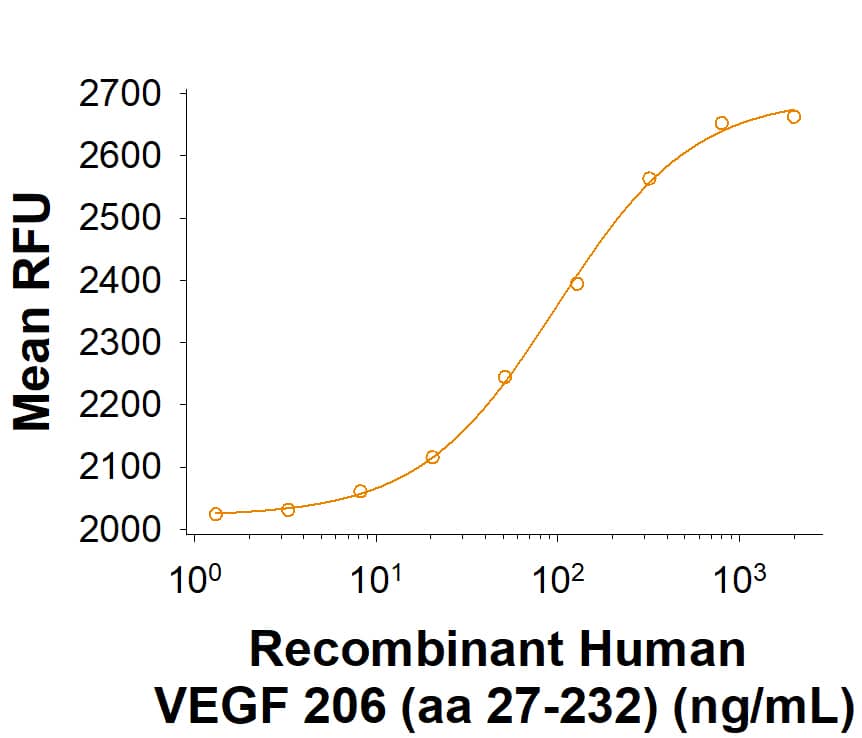Recombinant Human VEGF 206 (aa 27-232) Protein, CF
R&D Systems, part of Bio-Techne | Catalog # 10490-VE

Key Product Details
Source
E. coli
Accession #
Structure / Form
Disulfide-linked homodimer
Conjugate
Unconjugated
Applications
Bioactivity
Product Specifications
Source
E. coli-derived human VEGF protein
Ala27-Arg232
Ala27-Arg232
Purity
>90%, by SDS-PAGE visualized with Silver Staining and quantitative densitometry by Coomassie® Blue Staining.
Endotoxin Level
<0.10 EU per 1 μg of the protein by the LAL method.
N-terminal Sequence Analysis
Ala27
Predicted Molecular Mass
24 kDa
SDS-PAGE
26-30 kDa, under reducing conditions.
Activity
Measured in a cell proliferation assay using HUVEC human umbilical vein endothelial cells.
The ED50 for this effect is 20-160 ng/mL.
The ED50 for this effect is 20-160 ng/mL.
Scientific Data Images for Recombinant Human VEGF 206 (aa 27-232) Protein, CF
Recombinant Human VEGF 206 (aa 27-232) Protein Bioactivity.
Recombinant Human VEGF 206 (aa 27-232) Protein (10490-VE) stimulates proliferation of HUVEC human umbilical vein endothelial cells. The ED50 for this effect is 20-120 ng/mL.Recombinant Human VEGF 206 (aa 27-232) Protein SDS-PAGE.
2 μg/lane of Recombinant Human VEGF 206 (aa 27-232) Protein (Catalog # 10490-VE) was resolved with SDS-PAGE under reducing (R) and non-reducing (NR) conditions and visualized by Coomassie® Blue staining, showing bands at 26-30 kDa and 38-44 kDa, respectively.Formulation, Preparation and Storage
10490-VE
| Formulation | Lyophilized from a 0.2 μm filtered solution in HCl. |
| Reconstitution | Reconstitute at 250 μg/mL in 4 mM HCl. |
| Shipping | The product is shipped at ambient temperature. Upon receipt, store it immediately at the temperature recommended below. |
| Stability & Storage | Use a manual defrost freezer and avoid repeated freeze-thaw cycles.
|
Background: VEGF
References
- Woolard, J. et al. (2009) Microcirculation 16:572.
- Ferrara, N. et al. (2003) Nat. Med. 9:669.
- Robinson, C.J. and S.E. Stringer (2001) J. Cell. Sci. 114:853.
- Byrne, A.M. et al. (2005) J. Cell. Mol. Med. 9:777.
- Robinson, C.J. and S.E. Stringer (2001) J. Cell. Sci. 114:853.
- Burchardt T. et al. (1999) IUBMB Life. 48:405.
- Ferrara N. (2010) Mol Biol Cell. 21:687.
- Weis, S.M. and D.A. Cheresh (2005) Nature 437:497.
- Thurston, G. (2002) J. Anat. 200:575.
- Carvalho, J.F. et al. (2007) J. Clin. Immunol. 27:246.
- Angelo, L.S. and R. Kurzrock (2007) Clin. Cancer Res. 13:2825.
Long Name
Vascular Endothelial Growth Factor
Alternate Names
MVCD1, VAS, Vasculotropin, VEGF-A, VEGFA, VPF
Entrez Gene IDs
Gene Symbol
VEGFA
UniProt
Additional VEGF Products
Product Documents for Recombinant Human VEGF 206 (aa 27-232) Protein, CF
Product Specific Notices for Recombinant Human VEGF 206 (aa 27-232) Protein, CF
For research use only
